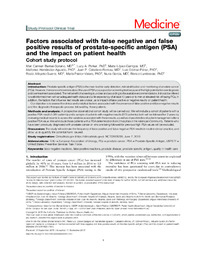Por favor, use este identificador para citar o enlazar este ítem:
https://hdl.handle.net/11000/30532Registro completo de metadatos
| Campo DC | Valor | Lengua/Idioma |
|---|---|---|
| dc.contributor.author | Bernal-Soriano, Mari Carmen | - |
| dc.contributor.author | Parker, Lucy Anne | - |
| dc.contributor.author | Lopez-Garrigos, Maite | - |
| dc.contributor.author | Hernández-Aguado, Ildefonso | - |
| dc.contributor.author | Caballero-Romeu, Juan-Pablo | - |
| dc.contributor.author | Gómez-Pérez, Luis | - |
| dc.contributor.author | ALFAYATE | - |
| dc.contributor.author | Pastor-Valero, Maria | - |
| dc.contributor.author | García, Nuria | - |
| dc.contributor.author | Lumbreras, Blanca | - |
| dc.contributor.other | Departamentos de la UMH::Salud Pública, Historia de la Ciencia y Ginecología | es_ES |
| dc.date.accessioned | 2024-01-17T17:42:37Z | - |
| dc.date.available | 2024-01-17T17:42:37Z | - |
| dc.date.created | 2019-10 | - |
| dc.identifier.citation | Medicine 2019 Oct; 98(40) | es_ES |
| dc.identifier.issn | 1536-5964 | - |
| dc.identifier.issn | 0025-7974 | - |
| dc.identifier.uri | https://hdl.handle.net/11000/30532 | - |
| dc.description.abstract | Prostate-specific antigen (PSA) is the main tool for early detection, risk stratification and monitoring of prostate cancer (PCa). However, there are controversies about the use of PSA as a population screening test because of the high potential for overdiagnosis and overtreatment associated. The net benefit of screening is unclear and according to the available recommendations, it should be offered to well-informed men with an adequate health status and a life-expectancy of at least 10 years or to men at elevated risk of having PCa. In addition, the factors that influence test results are unclear, as is impact of false positive or negative results on patient health. Our objective is to assess the clinical and analytical factors associated with the presence of false positive and false negative results and the diagnostic/therapeutic process followed by these patients. Methods and analysis: A prospective observational cohort study will be carried out. We will include a cohort of patients with a positive PSA result (1.081 patients) and a sample of patients with negative results (572 patients); both will be followed for 2 years by reviewing medical records to assess the variables associated with these results, as well as characteristics of patient management after a positive PSA value. We will include those patients with a PSA determination from 2 hospitals in the Valencian Community. Patients who have been previously diagnosed with prostate cancer or who are being followed for previous high PSA values will be excluded. Discussion: The study will estimate the frequency of false positive and false negative PSA results in routine clinical practice, and allow us to quantify the potential harm caused | es_ES |
| dc.format | application/pdf | es_ES |
| dc.format.extent | 7 | es_ES |
| dc.language.iso | eng | es_ES |
| dc.publisher | Wolters Kluwer Health | es_ES |
| dc.rights | info:eu-repo/semantics/openAccess | es_ES |
| dc.rights.uri | http://creativecommons.org/licenses/by-nc-nd/4.0/ | * |
| dc.subject | false negative reactions | es_ES |
| dc.subject | false positive reactions | es_ES |
| dc.subject | prostate disease | es_ES |
| dc.subject | prostate-specific antigen | es_ES |
| dc.subject | quality in health care | es_ES |
| dc.subject.other | CDU::6 - Ciencias aplicadas::61 - Medicina | es_ES |
| dc.title | Factors associated with false negative and false positive results of prostate-specific antigen (PSA) and the impact on patient health | es_ES |
| dc.type | info:eu-repo/semantics/article | es_ES |
| dc.relation.publisherversion | https://doi.org/10.1097/MD.0000000000017451 | es_ES |

Ver/Abrir:
13-Medicine-2019.pdf
297,94 kB
Adobe PDF
Compartir:
 La licencia se describe como: Atribución-NonComercial-NoDerivada 4.0 Internacional.
La licencia se describe como: Atribución-NonComercial-NoDerivada 4.0 Internacional.
.png)